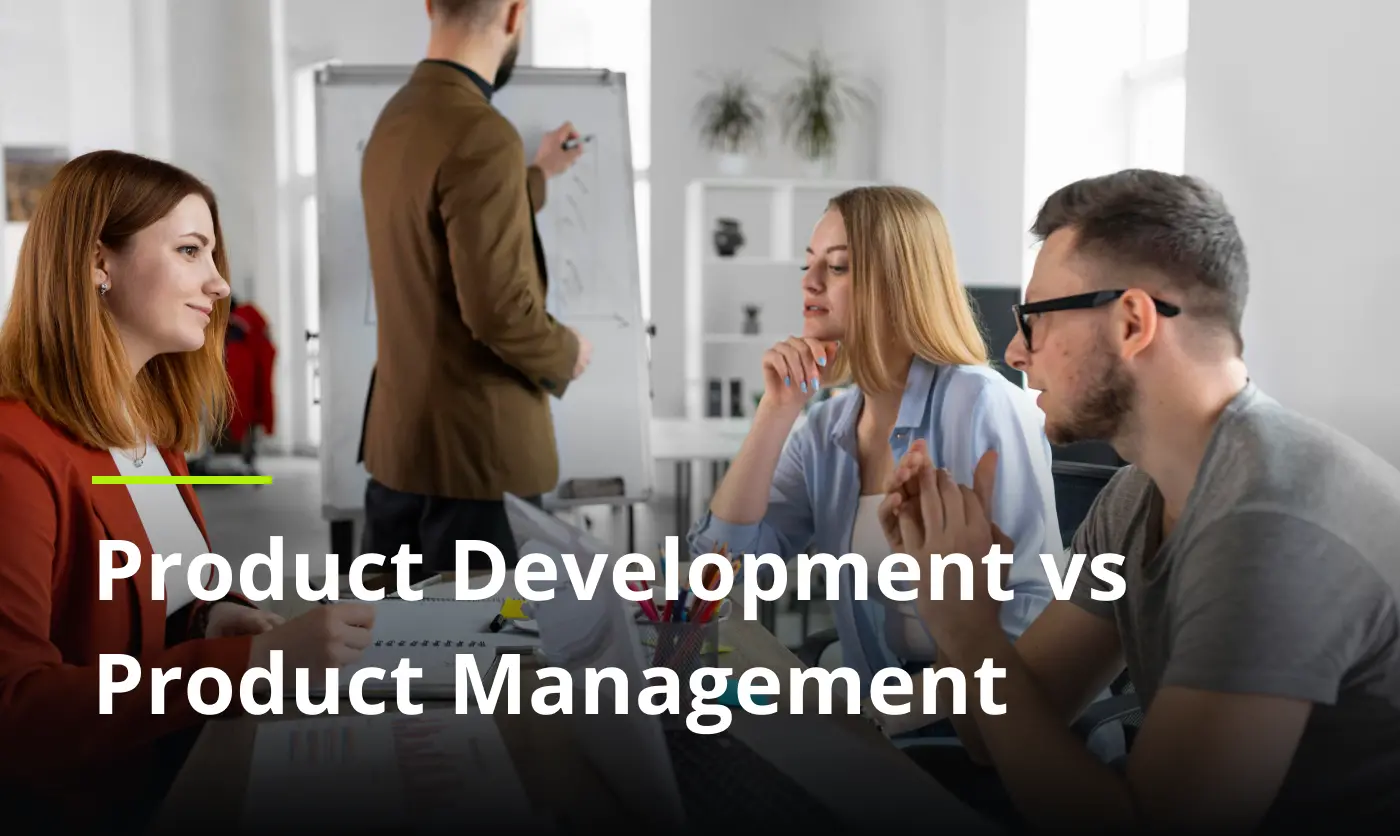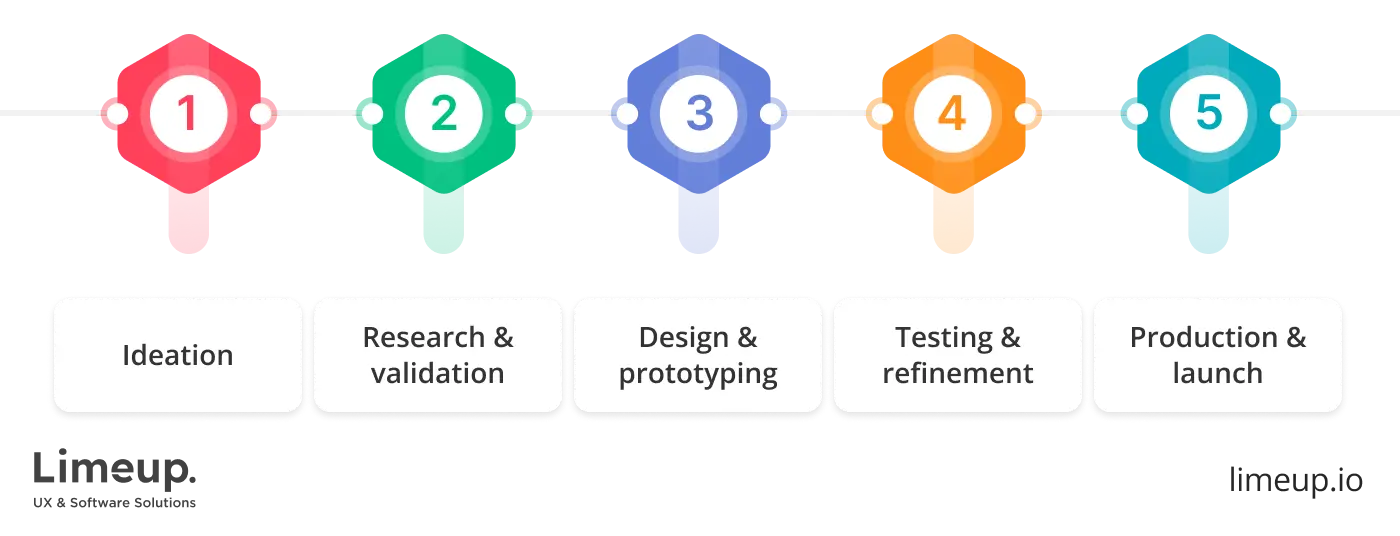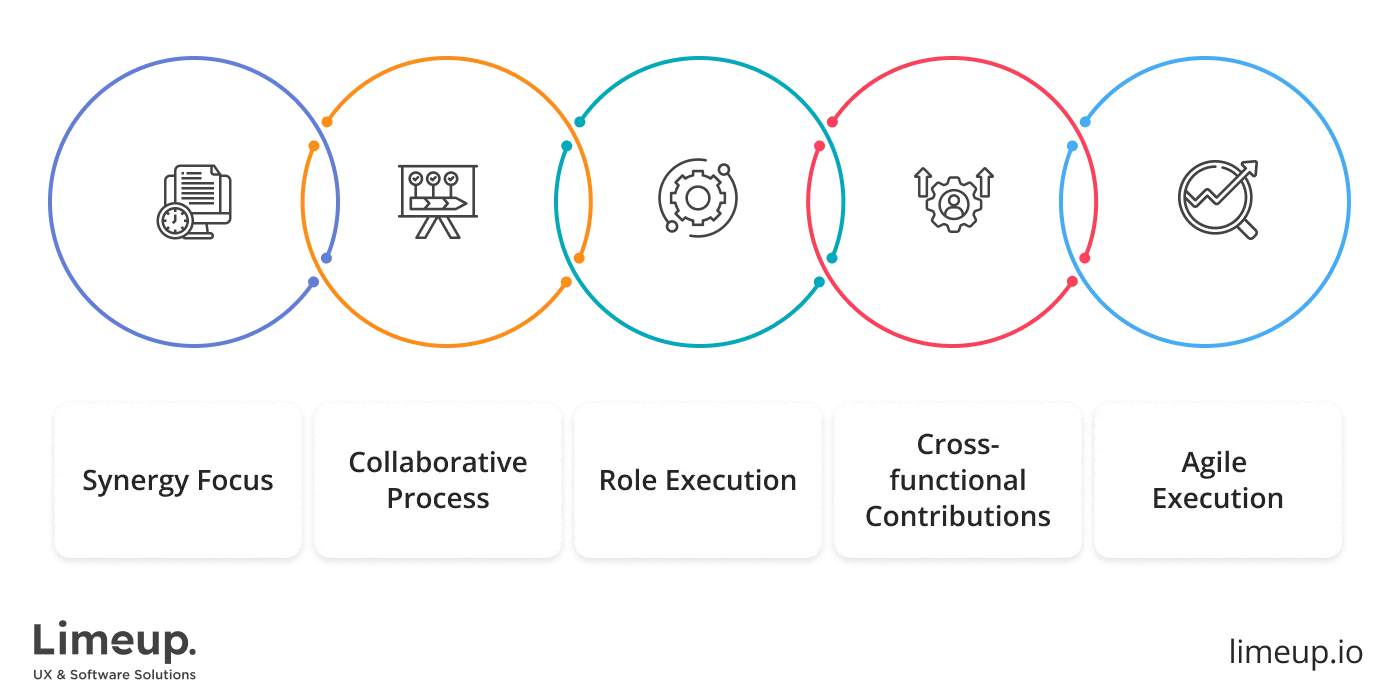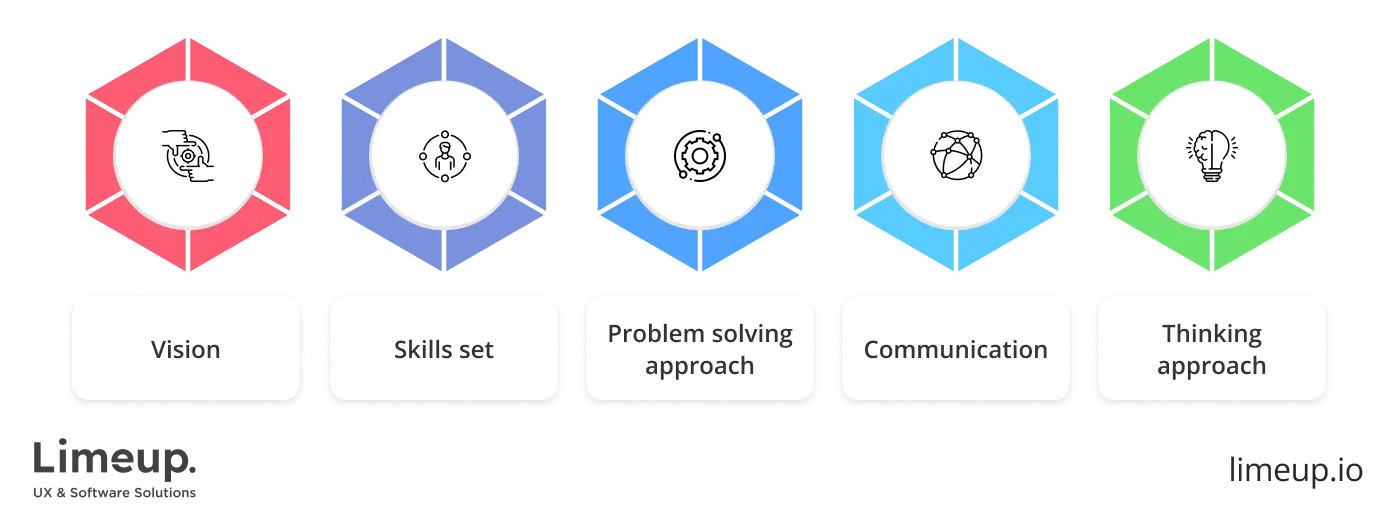Product Development vs Product Management: Detailed Comparison

In the cutthroat scene of product generation, the contrasting of product development vs product management highlights how both disciplines equally impact project success because of their different means of implementing the same result.
We will study the salient features of both product management and product development, highlighting their distinctions and areas of cooperation, in order to investigate how product creation maintains strategic alignment with company goals and how managing products generates success in competitive marketplaces.
What is product development?
Turning an idea into a completed product that meets customer needs and is ready for market launch is what we call product development. In truth, it’s no walk in the park — it’s a challenging process that involves product discovery, designing the project, creating a prototype, testing its performance, making adjustments based on feedback and finally launching the product.
This journey is far from a straightforward path; it’s more of a winding road full of unexpected twists and turns. Concept and execution go hand in hand, requiring agility and adaptability. Take Apple, for example. When they introduced the iPhone in 2007, they didn’t just bring a new player to the table — they turned the mobile phone industry on its head. Apple sold 1.4 million iPhones in 2007 with 80% of the sales coming in Q4.
Product development definition may be described in terms of distinct stages, which are discussed below:

Ideation. It is a well-known saying that all must begin with an idea. Prior to developing any product, businesses assess the market, do research, ascertain the needs and desires of people and then make recommendations for potential fixes. SWOT analysis is a powerful tool, helping to uncover a product’s weak spots while highlighting areas ripe with potential.
Research and validation. When an idea pops up, it’s time to let the wheels start turning. At this point, assumptions are made regarding the proposed product’s acceptance by the market. Predicting market trends, closely monitoring competitors and delving into consumer behavior are all indispensable for staying ahead of the curve and avoiding barking up the wrong tree with an undesirable product or copying what’s already out there.
Design and prototyping. Following this is the specification of the product that we are going to develop. During this phase, both designers and engineers collaborate within the product development role to create prototypes. By definition, a prototype is an initial version of a product that will need to be experimented with and probably modified. This is where creativity and functionality are shattered as teams evaluate if the product is viable and whether it works.
Testing and refinement. Testing is required to happen when the prototype is finished and user feedback is desperately needed at this point. This phase has been extremely beneficial to businesses like Tesla as they continue to refine their electric vehicles.
One of their continuous manufacturing strategies that guarantees the product keeps improving even after launch is the regular release of software updates along with feature improvements. In 2019 Tesla provided an over-the-air (OTA) upgrade that increased the current Model S and Model X vehicles’ range by up to 5%.
Production and launch. After multiple iterations of testing and refinement, the product is now ready for mass production. But launching a product involves more than merely pressing the “go” button on a production line. A carefully thought-out marketing plan will lock in that the product reaches its intended market as effectively as possible.
What is product management?
Managing products is usually characterized as the ability to manage several activities at the same time. Verifying that a product surfaces and succeeds in the market is a challenging role situated at the intersection of business, technology and user experience. Because of this complexity, a lot of people look to product development companies for their knowledge and experience in handling these difficult procedures.
Product creation is all about bringing a product into existence, while product management directs the entire process by coordinating teams, strategies and customer requirements in order to lead the product’s journey from idea to commercial success.
Both vision and execution are central to the function of the product supervisor. The introduction of the iPhone saw Steve Jobs take on the reputation of one of the best-known visionaries who personified the management of products.
The product management definition centers around a discipline that primarily focuses on problem-solving. A product manager’s job is to ascertain what customers need, translate that into features for the product and collaborate with cross-functional teams to make it all happen. Here’s a breakdown of the key responsibilities:

Vision and strategy. Every superb product begins with a dream. Creating a cohesive strategy for the long term is the responsibility of the PM, in order to meet both customer needs and strategic business goals. In the words of 68% of product managers, it is their job to define the product vision.
Market research and analysis. Product executives must understand what the marketplace is doing at any given moment. It requires an intense research technique to understand client difficulties, trends that are emerging, and the competitive landscape. Spotify, which began in 2008, rose to prominence as a trailblazer in music streaming because its product managers identified a need for low-cost, user-friendly music access.
Prioritization and roadmapping. Because there are so many ideas, characteristics and opinions from different important stakeholders, the product management role frequently requires ongoing prioritization.
Such activity is about recognizing what features need to be emphasized, knowing what is less important, and how to allocate resources. It makes perfect sense that many product managers are challenged by prioritization, one of the toughest parts of their job.
Collaboration with teams. Product managers are commonly called ‘mini-CEOs’ because they oversee a number of product development aspects. Close collaboration is maintained with partners spread throughout the engineering to marketing fields to ensure that the product itinerary is adhered to and to address arising issues.
A popular case is the partnership between Nike and their product managers, who in 2012 designed the FuelBand. Though its success was short-term, it did illustrate Nike’s talent for pioneering using effective product supervision.
Product development vs product management: differences and similarities
As said above, a manager focuses on the “what” and “why” sides of the product creation, while developers help answer the question of how it will be created. Here is the recap of the key responsibilities of these two positions:
We shall clearly distinguish between a manager and a developer in this part, emphasizing the differences and similarities between the two roles.
Differences
Developers are expert followers and executors, whereas managers are planners and strategists. Yet, managers may always rely on the technical know-how and expert insights of developers to properly plan out the project and establish realistic targets.

Additionally, managers focus on the project’s influence on users and the business, whilst developers are more concerned with the specifics and the practical aspects of project implementation.
Besides, managers are responsible for the strategic and creative part of the project, thoroughly planning the tasks and keeping all team members on the same page. They are like the building blocks connecting different tech professionals together and ensuring they all work for the same purpose.
In contrast to this, developers are executors whose task is to stick to the strategy and complete tasks on time.
Similarities
Despite the difference between product development and product management, these two roles have similarities as well. Both managers and developers play a crucial role at all stages of the product lifecycle, particularly when it comes to the creation of tech solutions. Both experts focus on the product itself and work piquantly turning a concept into a relevant full-scale solution.

Being able to gain user insights that will be turned into technical and strategic project path manager and developer leverage their collaborative skills, collective brainstorming, knowledge sharing, helping hand lending and many other hard and soft skills that allow them to cooperate cohesively from the initial planning to post-release phases.
How these two roles work together
While there are many distinctions and similarities between managers and developers, this distinction isn’t the most important thing to concentrate on for your project. What really matters is the synergy that arises from developers and managers working together to integrate corporate objectives with user needs and project-specific technological requirements.

Participation of managers and developers in a joint process is targeted towards providing insights and making the development process effective and risk-averse. Managers and product engineers jointly outline their vision, setting agreed-upon goals, priorities and ensuring glitch-free deployment strategies that will be appealing to audiences.
In translation, developers have an essential part in putting the shared aspiration into concrete results. By drawing from their technical knowledge, they create new answers that remain consistent with market needs and the project specifications indicated by management.
In various situations, managers may hold skills in development and take over certain elements of the project’s work, for instance, designing prototypes or checking features. Likewise, an engineer is able to shoulder some aspects of the manager’s role over the technical teams, increasing from a skilled developer to an experienced technical team lead.
Normally, each role is assigned to a different professional for the purpose of productive task management and successful project completion. Collaboratively, these professionals guarantee that the item they deliver is both technically strong and easy to use, plus it is highly attractive to customers.
Product developer vs product manager: dissimilarity in skills
Despite the fact that you might readily assume otherwise, the roles of a product manager and developer are separated by their talents and objectives. The novel product’s production involves distinct components, techniques, and skills from both of these entities.

Products are crafted on a framework of workmanship. What is a product developer? A product engineer is a talented individual who turns plans into realistic products. In their occupations, they should be well-equipped with detailed technical abilities, an emphasis on accuracy, and a problem-solving approach.
Rather than that, the product manager serves as the strategic visionary, overseeing everything that occurs. They base their work on what the final product should resemble, emphasizing how vital it is for customers and how it coordinates with larger business goals.
Expectations for a product engineer include a solid grounding in technology. Their responsibilities include supervising technologies in their profession, which range from hardware to a variety of programming languages. The ability to correctly execute tasks coupled with clear critical thinking and a talent for problem-solving is needed for this job.
Product managers could instead dedicate their expertise to key business aspects, such as strategic thinking, market research and communication. Their job is to align product features with the client’s needs as well as the organizational goals. Collectors of consumer feedback, aware of trends and developers of roadmaps that prioritize features to meet market needs are skills that product administrators have learned.
Designers of products will solve technological issues, correct flaws and provide faultless performance. The primary goal is to lessen the likelihood of mistakes; this raises quality but lowers risk tolerance.
Still, in a competitive market, what is a product manager if not someone who regularly takes calculated chances to propel their product forward? Professionals have to tread carefully when deciding which elements are most important to prioritize and which ones can be dropped due to time or financial constraints.
Another major disparity between the roles is in the area of communication — developers usually labor in different structures, paying a great deal of attention to programming or product planning. They work largely in technology teams and often include slang and technical information that non-technicians may not be able to understand.
However, product managers glue the departments together with which they work. For them, efficient information sharing between participants in the marketing, finance, design and engineering domains is necessary. As shown by the Harvard Business Review, poor communication contributes to 60% of the failure of products, underscoring the critical job of the manager in clarifying goals and priorities.
Product developer is data-hungry, which frequently entails gathering and analyzing performance metrics, conducting experiments and revising designs. Technical data competence is an essential element of efficiency, drawing the ability to identify problems. Data-driven businesses are more likely to hold on to consumers over 7 times, be profitable by about 19 times and outperform competitors 23 times at client acquisition.
People might still be more receptive to product managers’ design thinking since it analyses people’s journeys, foresees their needs and converts those needs into clear, easy-to-use solutions. Product managers, on a different note, would need to incorporate data in order to make more strategic judgments.
Concluding on the difference between product management and product development
The successful design of a product and its successful launch are largely dependent on the contributions of two crucial roles: product management and product development. Product managers oversee the project’s strategic customer-driven perspective, making sure that the product being developed is correctly aligned with the needs of the market and the company’s objectives.
Conversely, product developers roll up their sleeves to turn the concept’s technology realization into an improved, useful remedy. When these roles join forces, the result is a powerful synergy that makes a product competitive, inventive and feasible all at once.
Strategy and execution are smoothly synchronized when managers and engineers are on the same page, which enables them to avoid pitfalls and capitalize on their knowledge. Such kind of cooperation is the key to hitting goals and exceeding expectations while staying under budget and delivering exactly what’s necessary. Ready to reinforce your team? — contact Limeup for a complimentary call.
Bringing to the table over 10 years of experience, we have cultivated a team of top-notch managers and a team of developers that 93% consists of middle and senior-level specialists offering projects needs evaluation and development of a solution that 100% meets your objectives.

